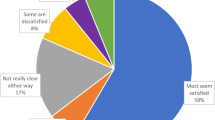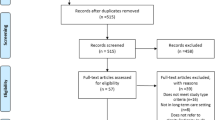Abstract
Background: Standards, benchmarking, and audits are integral to quality monitoring in health and social service provision. Recent policy in the UK National Health Service dictating the need for increased consumer involvement necessitates that service users have significant input into the composition of standards for quality of care.
Objective: To report the authors’ recent involvement in research towards developing a set of agreed, measureable statements regarding quality in the provision of continence services using the views of older service users.
Methods: This article focuses on the third of a three-stage project to involve, identify, and incorporate the views of older continence service users in the development of standards of care in continence services. Whereas stage 1 developed a questionnaire with the assistance of service users, and stage 2 piloted this as a postal survey in two contrasting areas, stage 3 applied the tool in the context of face-to-face interviews with more vulnerable older people. The approach also included open-ended questions to elicit qualitative data around experiences of continence service provision.
Results: Earlier stages of the project involved the relatively unproblematic construction of standards based on views given by experts and focus groups of older people. However, more in-depth, semi-structured interviews with service users brought to light the holistic, complex, and subjective way in which the sample viewed their experiences.
Conclusions: This study raises a number of questions over the efficacy of simple statements in capturing what is important to service users. If such standards are to empower patients usefully and assist professionals informatively in their provision of high-quality care, greater effort and sophistication is needed to truly reflect the needs and interests of service users. Alongside these concerns, however, there are potential ways of bridging the gap between standard setting and the lived patient experience.

Similar content being viewed by others
References
Williamson C. Whose standards? Consumer and professional standards in health care. Buckingham: Open University Press, 1992
Power M. The audit society: rituals of verification. Oxford: Oxford University Press, 1997
Alaszewski A. The impact of the Bristol Royal Infirmary disaster and inquiry on public services in the UK. J Interprof Care 2002 Aug; 16(4): 371–8
Department of Health. The new NHS, modern, dependable. London: HMSO (Cm 3807), 1997
Baggott R. A funny thing happened on the way to the forum? Reforming patient and public involvement in the NHS in England. Public Adm 2005 Aug; 83(3): 533–51
Cooper L, Coote A, Davies A, et al. Voices off? Tackling the democratic deficit in health. London: Institute for Public Policy Research, 1995
Department of Health. The NHS plan: a plan for investment, a plan for reform. London: Stationery Office, 2000
Mechanic D. Dilemmas in rationing health care services: the case for implicit rationing. BMJ 1995 Jun 24; 310(6995): 1655–9
HM Treasury. Wanless report: final report 2002 [online]. Available from URL: http://www.hmtreasury.gov.uk/Consultations_and_Legislation/wanless/consult_wanless_final.cfm [Accessed 2005 Dec 6]
Flynn R. Clinical governance and governmentality. Health Risk Soc 2002 Dec; 4(2): 155–70
Department of Health. The essence of care: patient-focused benchmarking for health care practitioners. London: Stationery Office, 2001
Walker A. Extending quality life: policy prescriptions from the growing older programme. J Soc Policy 2006 Jul; 35(3): 437–54
Gilleard C, Higgs P. Cultures of ageing: self, citizen and the body. Harlow: Prentice Hall, 2000
Newman A, Vidler E. Discriminating customers, responsible patients, empowered users: consumerism and the modernisation of health care. J Soc Policy 2006 Apr; 35(2): 193–209
Marcuse H. One dimensional man: studies in the ideology of advanced industrial society. Boston (MA): Beacon, 1964
Power M. Evaluating the audit explosion. Law Policy 2003 Jul; 25(3): 185–202
Marcuse H. From ontology to technology: fundamental tendencies of industrial society. In: Bronner S, Kellner D, editors. Critical theory and society: a reader. London: Routledge, 1989: 119–27
Burnside I, Preski S, Hertz JE. Research instrumentation and elderly subjects. J Nurs Scholars 1988 Jun; 30(2): 185–90
Walker E, Dewar EJ. How do we facilitate carers’ involvement in decision-making? J Advanced Nurs 2001 May; 34(3): 329–37
Bowling A. Measuring health: a review of quality of life scales. 2nd ed. Buckingham: Open University Press, 1997
Kelleher CJ, Cardozo LD, Khullar V, et al. A new questionnaire to assess the quality of life of urinary incontinent women. Br J Obstet Gynaecol 1997 Dec; 104(12): 1374–9
McDonald A, Langford H. Observations and recommendations for assessing patient satisfaction in a primary care setting using a previously validated questionnaire. Health Soc Care Community 2000 Mar; 8(2): 109–18
Edwards C, Staniszewska S. Accessing the user’s perspective. Health Soc Care Community 2000 Nov; 8(6): 417–24
Flick U. An introduction to qualitative methods. Thousand Oaks (CA): Sage Publications, 1988
Fisher AL. Just what defines frailty? J Am Geriatr Soc 2005 Dec; 53(12): 2229–30
Gill TM, Allore HG, Hardy SE, et al. The dynamic nature of mobility disability in older persons. J Am Geriatr Soc 2006 Feb; 54(2): 248–54
Darzi A. Our NHS our future [online]. Available from URL: http://www.networks.nhs.uk/news.php?nid=1802 [Accessed 2008 Jul 18]
Donabedian A. Evaluating the quality of medical care. Millbank Mem Fund Q 2006 Sep; 44(3 Suppl.): 166–206
Hall R. Organizations: structure, process and outcomes. Englewood Cliffs (NJ): Prentice-Hall, 1987
Department of Health. New arrangements for clinical audit [online]. Available at URL: http://nds.coi.gov.uk/environment/fullDetail.asp?ReleaseID=349219&NewsAreaID=2&NavigatedFromDepartment=False [Accessed 2008 Jul 18]
Wilson I, Cleary P. Linking clinical variables with health-related quality of life: a conceptual model of patient outcomes. JAMA 1995 Jan; 273(1): 59–65
Kennedy H. Just law: the changing face of justice — and why it matters to us all. London: Secker & Warburg, 2004
Power M. The audit explosion. London: Demos, 1994
Royal College of Physicians. National audit of continence care for older people: report of the National Audit of Continence Care for Older People (65 years and above) in England, Wales and N Ireland [online]. Available from URL: http://www.rcplondon.ac.uk/clinical-standards/ceeu/current-work/documents/generichospital2006.pdf [Accessed 2010 Jan 14]
Royal College of Physicians Clinical Effectiveness and Evaluation Unit. National sentinel stroke audit. Phase I (organisational audit) 2006. Phase II (clinical audit) 2006. Report for England, Wales and Northern Ireland. London: 2007 Apr [online]. Available from URL: http://www.rcplondon.ac.uk/pubs/books/strokeaudit/strokeaudit2006.pdf [Accessed 2008 Jul 18]
Means R, Smith R. The development of welfare services for elderly people. London: Croom Helm, 1985
Coyne K, Matza L, Kopp Z, et al. The validation of the Patient Perception of Bladder Condition (PPBC): a single-item global measure for patients with overactive bladder. Eur Urol 2006 Jun; 49(6): 1079–86
Chouliara Z, Kearney N, Worth A, et al. Challenges in conducting research with hospitalised older people with cancer: drawing from the experience of an on-going interview based project. Eur J Cancer Care 2004 Dec; 13(5): 409–15
Rowland RM, Fisher KJ, Green M, et al. Recruiting inactive older adults to a neighbourhood walking trial: the SHAPE project. J Aging Stud 2004 Aug; 18(3): 353–68
Addington-Hall J. Research sensitivities to palliative care patients. Eur J Cancer Care 2002 Sep; 11(3): 220–4
Billings J, Macvarish J. Teenage parents’ views of sex and relationships education and family support services: antenatal report. Canterbury: University of Kent, 2007
Acknowledgments
Grants for the conduct of this study were received from the British Geriatrics Society and the Charitable Trustees of the Royal College of Physicians. These funders had no role in the design, management, analysis, interpretation, or presentation of the findings. Two of the authors (Dr Wagg and Dr Potter) are affiliated with the Royal College of Physicians.
Author information
Authors and Affiliations
Corresponding author
Rights and permissions
About this article
Cite this article
Brown, P., Billings, J., Wagg, A. et al. Is it Possible to Measure What Truly Matters? The Paradox of Clinical Audit in Developing Continence Service Standards for Older People. Patient-Patient-Centered-Outcome-Res 3, 11–23 (2010). https://doi.org/10.2165/11318800-000000000-00000
Published:
Issue Date:
DOI: https://doi.org/10.2165/11318800-000000000-00000




